:::::::::::::::::::::::::::::::::::::::::::::::::::::::::::::::::::::::::::::::::::::::::::::::::::::
Bell, temple bell (kane)
***** Location: Japan
***** Season: Non-seasonal Topic
***** Category: Humanity
*****************************
Explanation

庄田耕峰 Shoda Koho (1871-1946)
First some kinds of bells we find in a Japanese temple.
They all serve a different purpose and look quite different. The large temple bell, kane, has its own bell tower.
temple bell, kane 鐘
hanging temple bell, tsurigane 釣鐘
"crocodile's mouth", waniguchi 鰐口
bronze bell, dootaku 銅鐸
small bell, suzu 鈴
:::::::::::::::::::::::::::::::::::::::::::::::::::::::::::::::::::::::::::::::::
Look at the large temple bell.
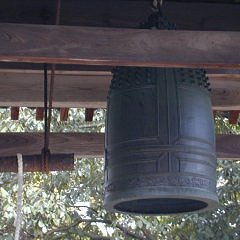
http://www.01.246.ne.jp/~yo-fuse/bungaku/kakikueba/kakikueba.html
柿くへば鐘が鳴るなり法隆寺
kaki kueba kane ga naru nari Hooryuji
(正岡子規 Masaoka Shiki, 25-26/10/1895)
eating a persimmon -
the bell reveberates
at Horyu-ji temple
(Tr. Gabi Greve)
Shiki talks about a large bronze temple bell, which is not really RINGING like a church bell, but produces a sort of booming reverberating sound when stuck with a huge wooden log.
Usually when a large temple bell is struck like this, you stand there, fold your hands, close your eyes and listen until the vibrations of the sound produced in your body are completely vanished, which can be quite a long time with some of these large bells.
The bell of the temple Horyu-ji reverberates like an echo in the mountains in the background of the temple and seems to envelop the whole area. I am sure Shiki was completely wrapped up in the deep vibrating sound of this bell too.
Gabi Greve
. Haiku and Temple Horyu-Ji
parts of a bonshoo 梵鐘 temple bell

source : www.terakoya.com
:::::::::::::::::::::::::::::::::::::::::::::::::::::::::::::::::::::::::::::::::::::::::::::::::::::
Tenkaizan 泰運寺 Taiun-Ji
天開山 泰運寺の八角大釣鐘 / 松阪市飯高町波瀬 Matsusaka town
Temple bell with six corners

CLICK for enlargement !
- source : kito on facebook
:::::::::::::::::::::::::::::::::::::::::::::::::::::::::::::::::::::::::::::::::::::::::::::::::::::
OF PERSIMMONS AND BELLS
WHC Translation Project of Haiku Poems by Masaoka Shiki
Read the details of this interesting discussion
HERE !!!!!
And an earlier poem of Natsume Soseki, that inspired Shiki to write his hokadori allusion !
*****************************
Worldwide use

Himalayan Singing Bowls
Singing bowls (also known as 'Himalayan bowls' or 'rin gongs' in Japan) are a type of bell, specifically classified as a standing bell. Rather than hanging inverted or attached to a handle, standing bells sit with the bottom surface resting. The sides and rim of singing bowls vibrate to produce sound.
Singing bowls were traditionally used throughout Asia as part of Buddhist meditation practice. Today they are used worldwide for meditation, relaxation, healthcare, personal well-being and religious practice.
© More in the WIKIPEDIA !
:::::::::::::::::::::::::::::::::::::::::::::::::::::::::::::::::::::::::::::::::::::::::::::::::::::
Tibetan bell and Dorje
This use in the Himalayan area is similar to the singing bowls, see above.

The Tibetan bell and Dorje were created to facilitate centering the energy and quieting the mind. The striker is used to play the bell (stroking the base) to create harmonious sound. The Bell held in the left hand is an expression of the qualities of Compassion and Loving-Kindness. The Dorje held in the right hand, often near the heart, expresses qualities of Wisdom. An intricately carved, highly ornamental bell made of brass and bronze.
The wooden striker is used to strike the bell once and then rotate it around the rim of the bell to produce a rich, echoing, meditative hum during prayer. The brass bell has a special lacquer coating to prevent it from tarnishing.
http://www.bsbazaar.com/Spirituality/pd.aspx?sku=GFT723200372725YOG22
:::::::::::::::::::::::::::::::::::::::::::::::::::::::::::::::::::::::::::::::::::::::::::::::::::::
"Diamond Bell" (kongo rei)
Japanese Esoteric Buddhism uses a bell (kongoo rei 金剛鈴) and dorje (kongoshoo 金剛杖) too, but they are used in a different manner.

Kongosho (kongoosho) is the Japanase word for a vajra (Sanskrit) or dorje (Tibetan), which is a physical representation of the thunderbolt and believed to embody incisive powers with the potential to dispel hindrances to enlightenment.
The dorje represents the male principle, while the bell represents the female one.

I will add an article about these later.
External LINK for now
http://www.viewzone.com/dorje.html
*****************************
Things found on the way
TOKI NO KANE 時の鐘 The Bell to Tell the Time
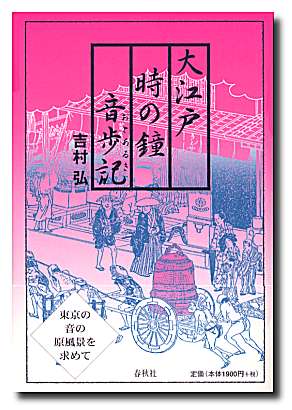
Bells were the clocks of Old Edo. Every temple compound had one ... some bell towers could also be used as lookouts for fire.
Even now in our mountains, we have the "bell" ringing at six in the morning, 12 for lunch and 5 when its quitten time. Farmers did not have watches and this was the way to regulate their day.
Only here, the bell has turned into a terrible siren. When we heard it first we thought war had started over night ....
Gabi Greve
. akemutsu 明け六つ the sixth double-hour of the morning .
kuremutsu 暮れ六つ the sixth double-hour of the evening

‘TIMING DAY AND NIGHT: TIMESCAPES IN PREMODERN JAPAN’
(15-17 April, 2015) - University of Cambridge
. Timescapes .
:::::::::::::::::::::::::::::::::::::::::::::::::::::::::::::::::::::::::::::::::::::::::::::::::::::::
鐘一つ 売れぬ日はなし 江戸の春
kane hitotsu urenu hi wa nashi Edo no haru
と川柳にも詠われているように、江戸時代、人々は「時の鐘」で時刻を知り、生活を営んでいた。それは情報音であると同時に、人々の暮らしのシンボル、あるいは地域のアイデンティティを形成していた。本書は、環境音楽作曲の第一人者が、現代の東京に残る「江戸」の余韻を、歴史的資料を片手にフィールドワークを試みたユニークな観察記である。日本橋石町から中目黒祐天寺まで、17箇所に設置された「時の鐘」をめぐり、江戸のサウンドスケープを活写するとともに、東京の音の原風景を求めて、江戸と東京をクロスオーバーさせて、音の文化のありようを探る。
http://www.shunjusha.co.jp/book/93/93474.html
:::::::::::::::::::::::::::::::::::::::::::::::::::::::::::::::::::::::::::::::::::::::::::::::::::::
~Kawagoe Nostalgia--The Bell of Time~
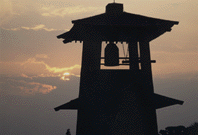
It is said that Sakai Tadakatsu, Lord of the Kawagoe Castle, built the bell tower between 1624-1643.
The present bell tower was rebuilt in 1893, the year following the Great Kawagoe Conflagration.
The bell tower is made of wood and consists of 3 floors. It is 16.2m tall.
Since its foundation in the Kanei era, the bell tower has been telling time for over 350 years, and is an important symbol of Kawagoe.
Currently, the bell rings out through the Kura-zukuri lined streets 4 times a day (6a.m., noon, 3p.m., 6p.m.).
The bell of time has been selected as one of the "100 Japanese Soundscapes" to keep (Hosted by the Enviromental Agency) in June, 1996.
Kawagoe Town Page
Click HERE to see more famous old
Bell Towers (toki no kane) of Japan
.............................................
The Temple Bell of Enryaku-ji was made in 858.
比叡山延暦寺の西塔宝幢院鐘
Click HERE to have a look.
.............................................
Bronze Bells, dootaku 銅鐸
from the Yayoi Period of Japan
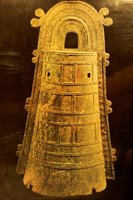
http://cla.calpoly.edu/~jwetzel/Japan/slides/slides-jpg/Dotaku.jpg
Dotaku, Bells in Japanese Buddhism and Shinto
Click HERE to see more Bronze Bells
holding
something of autumn
Yayoi bell
George O Hawkins
- Haiku Culture Magazine - February 2013
.............................................
"crocodile's mouth", waniguchi 鰐口
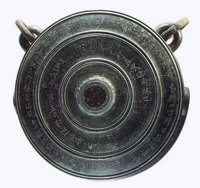
Waniguchi Miyagi
This type of gong hangs in front of the entrance to the temple hall and visitors may strike it before throwing their money into the box for offerings and then making their prayer/wish.
鰐口にちよいと加へし紅葉哉
waniguchi ni choi to kuwaeshi momiji kana
quickly stuffing
the temple gong...
red leaves
Tr. David Lanoue
. Kobayashi Issa 小林一茶 in Edo .
.......................................................................
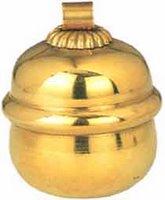
http://www.zenshukyo.or.jp/tool_3.html
Another smaller bell (suzu 鈴)can aso be found at a temple or shinto shrine, for the visitors to ring after making their offering. Small versions of a "suzu" are also attached to many talismans or made of clay (dorei 土鈴).
More about Temple Instruments:
Big Drum :Daiko 大鼓 and Tsuzumi 鼓
Dorei, Clay Bells sold at Temples
By Gabi Greve
:::::::::::::::::::::::::::::::::::::::::::::::::::::::::::::::::::::::::::::::::::::::::::::::::::::
Prayer Gong, kane 鉦
Here is a haiku by Issa, translated by David Lanoue
Mokuboji and Issa Haiku
木母寺の鉦の真似してなく水鶏
mokuboji no kane no mane shite naku kuina
mocking Mokubo Temple's
bell...
the moorhen calls
The kanji used for KANE here is 鉦, which is not the large temple bell as described above. It is a small kind of prayer gong.
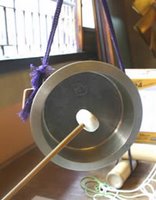
The sound in Japanese is represented as:
コンチキチン♪ .. konchiki chin
My translation would probably be, considering the many ladies praying at the temple
almost like the
prayer gongs at Temple Mokuboji -
the moorhen's call
The fruit cricket in Japan is called : kanetataki, 鉦叩き "prayer gong cricket".
Read this entry for more haiku.
抱た子や母が来るとて鉦たたく
. daita ko ya haha ga kuru tote kane tataku.
About his third son, Konzaburoo 金三郎 Konzaburo (Konsaburo)
. Kobayashi Issa 小林一茶 Issa in Edo .
:::::::::::::::::::::::::::::::::::::::::::::::::::::::::::::::::::::::::::::::::::::::::::::::::::::
The various Drums used in Buddhist Rituals
Gabi Greve
:::::::::::::::::::::::::::::::::::::::::::::::::::::::::::::::::::::::::::::::::::::::::::::::::::::
Event in New York, June 2011
five famous Kyoto Buddhist temple bells, called
Chionin, Toji, Nanzenji, Honganji, and Ohara
by sound-sculptor, Bill Fontana
Here is a link to a website giving the artist's explanation of the work:
http://resoundings.org/Pages/Silent_Echoes.html
*****************************
HAIKU
鐘一つ 売れぬ日はなし 江戸の春
kane hitotsu urenu hi wa nashi Edo no haru
寶井其角 Takarai Kikaku (1661-1707)
spring in Old Edo -
not a day without a
temple bell sold
(Tr. Gabi Greve)
Kikaku writes this haiku in praize of the thriving business spirit and rapid development of the city, O-Edo 大江戸, in his time, when even a thing as huge as a temple bell, which usually does not sell every day, was sold by the dozens.
Kikaku is of course exagerating in his haiku. But that time, Edo had already more than one million inhabitants and was one of the most populated towns on earth.
The following is a contribution by Larry Bole:
Blyth uses 'wa' instead of 'ha'. His translation is rather wordy:
These great temple bells --
There is no day when one's not sold:
Springtime in Edo.
Blyth goes off on a lengthy 'riff' on this haiku, dragging in the "Yuimakyoo" amd Sooshi (Chuangtze), among other references. But his basic contention is that "there are two poetical currents in this poem, one of hyperbole, and the other of self-identification, and these two are one stream," although he doesn't say why he thinks this is so.
He goes on to state that "we can find examples of hyperbole in many writers of haiku, but there is something in it foreign to the nature of haiku, which prefers understatement rather."
Here is one more translated version:
A single bell
you sell at least one each day
spring in Edo
(Tr. Michael Bourdaghs)
http://www.nycbigcitylit.com/feb2004/contents/poetrybourdaghs.html
:::::::::::::::::::::::::::::::::::::::::::::::::::::::::::::::::::::::::::::::::::::::::::::::::::::
花の雲 鐘は上野か 浅草か
hana no kumo kane wa Ueno ka Asakusa ka
cloud of blossoms
is that the bell from Ueno
or Asakusa?
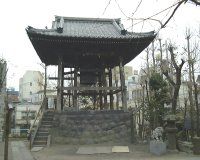
In the Edo-period, temple bells such as the one on the Benten Hill in Sensoji in Asakusa, played an important role in informing the townspeople of the time of day. Those bells were therefore called 'toki no kane,' or Bells of Time. The present bell dates from 1692, when it was cast at the orders of the shogun Tsunayoshi. The bell is more than 2 meters high and measures one and half meter in diameter.
Basho lived in Fukagawa, on the other bank of the River Sumida. In those times, when Fukagawa was in the rural outskirts of the city, he could probably see the roof of the great Kannon temple from his home.
Not far from Asakusa was another temple complex, Kaneiji, in what is now Ueno Park. Kaneiji also possessed a Bell of Time, now standing in a forlorn corner of the park. Basho could hear both temple bells. Sitting on the verandah of his house, among the blossoms of spring, he heard the boom of a bell... and wondered: was it the one of Kaneiji in Ueno or of the Kannon temple in Asakusa?
Basho was so visually drunk with the rioting blossoms that even his sense of direction became confused...
Copyright © 2003-2006 Ad G. Blankestijn, Japan.
ooo ooo ooo ooo ooo ooo ooo ooo ooo ooo ooo
. Yosa Buson 与謝蕪村 in Edo .
涼しさや鐘をはなるゝかねの聲
suzushisa ya kane o hanaruru kane no koe
Coolness!
The sound of the bell
Leaving the bell.
Tr. Earl Miner
Coolness -
From the bell depart
Its peals.
Tr. Nelson/Saito
Coolness,
When it leaves the bell
The voice of the bell.
Tr. Shoji Kumano
A coolness -
separating from the bell
The bell's voice.
Tr. Sawa/ Shiffert
Coolness --
the sound of the bell
as it leaves the bell.
Tr. Hass

source : blogs.yahoo.co.jp/nietzsche_rimbaud
釣鐘にとまりてねむる胡蝶かな
tsurigane ni tomarite nemuru kochoo kana
- quote
On the temple bell,
A butterfly has settled,
Sleeping.
Now on the surface there is not much to this. But the whole point of the verse is in knowing that the temple bell is a very heavy, cast metal object that is struck at certain hours of the day by a long, horizontal swinging pole; when struck, it emits a great, deep BBbbboooooooooooooonnnnnngngngngngng that vibrates not only the whole bell but all the air around it, sending out a sound that can be heard for a great distance. From that the perceptive reader will gather, correctly, that this is a hokku of “harmony of contrast.”
- - - MORE
source : David Coomler
stopping on the temple bell
the butterfly
asleep
Tr. Haldane
Perched upon
the temple-bell,
the butterfly sleeps!
Tr. Lafcadio Hearn
On the temple bell
has settled, and is fast asleep,
a butterfly.
Tr. Henderson
On that great temple bell
Stopped from flight and sleeping
The small butterfly.
Tr. Earl Miner
On a temple bell
Alights and naps
A butterfly.
Tr. Nelson/Saito
On the hanging bell,
staying while he sleeps,
a butterfly!
Tr. Sawa/ Shiffert
The small butterfly has caused a lot of wind !
Read more about Chuang Tzu, the Butterfly Dream and Haiku
Shiki's haiku was influenced by Buson's haiku about the butterfly asleep on the temple bell.
tsurigane ni tomarite hikaru hotaru kana
Henderson's versions of both haiku
On the temple bell
has settled, and is glittering,
a firefly.
(On the temple bell
has settled, and is fast asleep,
a butterfly.)
Blyth's versions of both haiku:
On the temple bell,
Glowing,
A firefly.
(The butterfly
Resting upon the temple bell,
Asleep.)
... ... ... Some other haiku in this context
Shiki:
issen no tsurigana tataku ya hirugasumi
One penny
and you get to ring the temple bell--
noonday haze
tr. Burton Watson
and a haiku that combines 'temple bell' AND 'withering wind':
kogarashi ya kane hikisutete michi no hata
The wintry gust:
they have left a temple bell
by the roadside.
tr. Ueda
Contribution from Larry Bole
World Kigo Database : Withering Wind (kogarashi)
:::::::::::::::::::::::::::::::::::::::::::::::::::::::::::::::::::::::::::::::::::::::::::::::::::::
Matsuo Basho
鐘撞かぬ里は何をか春の暮
kane tsukanu sato wa nani o ka haru no kure
Look at the Memorial Stone here !
A village where they ring
no bells! --- Oh, what do they do
at dusk in spring?
Henderson
village where they ring
no bells---how do they live?
nightfall in spring
Ueda Makoto
Ueda quotes Abe K.:
The hokku alludes to the monk Nooin's waka in Shinkokinshuu [no. 116]:
yamazato no
haru no yuugure
kite mireba
iriai no kane ni
hana zo chirikeru
Spring nightfall
in a mountain village
where, at the sound of a bell
tolling the close of a day,
cherry blossoms keep falling.
... ... ...
no bell ringing
on what does the village depend?
spring evening
Jane Reichhold
Reichhold says of this haiku:
Sora, Basho's companion on the journey to the north, recorded some of Basho's verses which were not recorded in Basho's account of the trip. His book was called Sora Tabi Nikki - Sora's Travel Diary.
Translating Haiku Forum
.................................................................................
鐘消えて花の香は撞く夕哉
kane kiete hana no ka wa tsuku yuube kana
The temple bell dies away
The scent of flowers in the evening
Is still tolling the bell.
Tr. R.H.Blyth
fading temple bell
the fragrance of flowers strikes
at evening
Tr. Jane Reichhold
the temple bell
still ringing in the scent
of evening flowers
Tr. Patrick Gillespie
This is a play about striking the temple bell and the nose being struck by the fragrance of the blossoms.
Like the lingering sound of the bell,
the lingering sound of the blossoms is still in the air, enhanced by the sound.

iriai no kane 入相の鐘 the bell rung at sunset.
It can be debated if this is a good haiku or not.
the sound of the temple bell fades
the fragrance of the cherry blossoms fades with it
this evening
Paraverse by Gabi Greve
MORE haiku about tempel bells by
. Matsuo Basho 松尾芭蕉 - Archives of the WKD .
:::::::::::::::::::::::::::::::::::::::::::::::::::::::::::::::::::::::::::::::::::::::::::::::::::::
. Chiyo-Ni 千代尼 .
鰐口の物言かぬる寒さかな
waniguchi no mono-ii kanuru samusa kana
it is so cold
the prayer gong can not say
even one word . . .
Tr. Gabi Greve
The cut marker KANA is at the end of line 3.
waniguchi 鰐口 "crocodile's mouth", even this mouth is shut in the cold.
- - - - -
each sound of
the temple bell is different
in the wind
I am still looking for the Japanese and the translator of this.
I wonder if it is the different sound of one bell
or the different sounds of many bells.
:::::::::::::::::::::::::::::::::::::::::::::::::::::::::::::::::::::::::::::::::::::::::::::::::::::
kangyoo ni naru shidan seshi kano kane ka
Seishi Yamaguchi
Bell in the cold dawn---
is that the same bell I struck
with my fingertips?
tr. Takashi Kodaira and Alfred H. Marks
This is from the book The Essence of Modern Haiku: 300 Poems by Seishi Yamaguchi, Kodaira and Marks, Atlanta, Mangajin, Inc., 1993.
It is accompanied by the following note:
Composed 1962.
At Senkoo-ji Temple, in Onomichi, I flicked my fingertips against the great bell for announcing the hours. The next morning, in the cold dawn, I heard the sound of the bell from my bed. Was that the same bell that made the tiny sound when I struck it with my fingers?
Contribution by Larry Bole
:::::::::::::::::::::::::::::::::::::::::::::::::::::::::::::::::::::::::::::::::::::::::::::::::::::
咲くからは 龍頭にとどけ 山桜
saku kara wa ryuuzu ni todoke yamazakura
if you are going to blossom
please reach the dragon head of the bell -
mountain cherry tree
Keishi 慶子 (けいし)
pen name of Nakamura Tomijuro the first
1719 - August 3, 1786
Kabuki actor and poet
Musume Dojoji 娘道成寺 Kabuki
:::::::::::::::::::::::::::::::::::::::::::::::::::::::::::::::::::::::::::::::::::::::::::::::::::::
草花や露の底なる鐘の声
kusa-bana ya tsuyu no soko naru kane no koe
wildflowers --
in the depths of the dew
the bell tolls
Kobayashi Issa
Tr. David Lanoue
:::::::::::::::::::::::::::::::::::::::::::::::::::::::::::::::::::::::::::::::::::::::::::::::::::::
月いづく鐘は沈める海の底
tsuki izuku kane wa shizumeru umi no soko
Matsuo Basho in Tsuruga
. The mystery background story
of the bell at the bottom of the sea
:::::::::::::::::::::::::::::::::::::::::::::::::::::::::::::::::::::::::::::::::::::::::::::::::::::
plant kigo for early summer
. hoochakusoo 宝鐸草(ほうちゃくそう)"temple chime plant".
Disporum sessile
hoochaku, hootaku 宝鐸 temple chime
*****************************
Related words
***** Temple bell on the last day of the year (joya no kane)

striking the bell, joya no kane 除夜の鐘
Kigo for New Year
***** Wind chimes (fuurin) 風鈴
Kigo for All Summer
***** Japanese Temples, Shrines and Haiku
***** Bells, Temple Bells and Haiku from India

dora 銅鑼 prayer gong
***** . WASHOKU
Dora 銅鑼 metal prayer gong and
the Dorayaki sweets どら焼き
:::::::::::::::::::::::::::::::::::::::::::::::::::::::::::::::::::::::::::::::::::::::::::::::::::::
. kane 鐘と伝説 Legends about the temple bell .
. ryuuzu 竜頭と伝説 Legends about the dragon head .
ryuuzu 竜頭 Ryuzu, "dragon head" - hook of a temple bell
:::::::::::::::::::::::::::::::::::::::::::::::::::::::::::::::::::::::::::::::::::::::::::::::::::::
Tempelglocke : Rituelle Instrumente Deutscher Text
. . . . . TEXT
Buddhistische Kultgegenstände Japans
:::::::::::::::::::::::::::::::::::::::::::::::::::::::::::::::::::::::::::::::::::::::::::::::::::::::::::::::::::::::::::
. Kobayashi Issa 小林一茶 in Edo .
無常鐘蝿虫めらもよつくきけ
mujô-gane hae mushimera mo yokku kike
the bell of impermanence --
you, too, puny flies
hey, listen up!
This humorous hokku is from the fourth month (May) in 1825, when Issa was alone, after having lost four children and his first wife and then having been divorced by his second wife the previous year. His health wasn't the best, and he died two years later, soon after he married his third wife.
In the hokku flies are buzzing around, and outside the big bell at the local Shin Pure Land temple in Issa's hometown seems to be booming. The rough, forceful language Issa uses to address the flies seems be a parody of a proud samurai insulting his enemies on the battlefield, since the first line is a quote from the famous first line of a 13th-century war chronicle, The Tale of the Heike (Heike monogatari), a narrative originally sung by wandering musicians about the rise and fall of the Taira warrior clan, which became the most powerful clan in Japan for about three decades in the second half of 12th century but was then completely wiped out by another warrior clan, the Minamoto or Genji clan, in a war ending in 1185. The chronicle opens with the image of a bell being rung at the Jetavana monastery in India, where Buddha preached the majority of his sermons. In the monastery a glass bell was rung when a monk was near death to indicate to the monk and to the other monks that all things are impermanent and that death is simply another form of change. Just as Buddha's teachings are often ignored by the warriors evoked in The Tale of the Heike, the flies that noisily circle Issa seem not to hear or care about the temple bell or its message.
Issa is only bantering with the flies, of course, and his evocation of fictional samurai facing each other in battle is playful, though waving away flies was surely a constant struggle in summer. Issa roughly orders the flies to awake from their ignorance and listen to the Buddha's message about the impermanence of all things, yet they show no signs of paying attention to him, so in the end the hokku turns inside out: the flies have no intention of listening to Issa, and his blustering half-samurai, half schoolteacherly mini-sermon only hides the fact that it is actually the "puny" flies who are stronger, not Issa. Issa's pompous lecture is a self-ironical humorous pose to begin with, but the fact that the flies actually ignore him does seem to leave him with a feeling of real powerlessness. Perhaps this reversal helps Issa -- and the reader -- to feel how subject he actually is to constant change and to the influence of other creatures, even tiny flies. Perhaps in this hokku Issa is recreating a spontaneous experience of Other-power, an experience of dependence that cannot be willed or consciously grasped: the Other-power of Amida Buddha. Issa seems to imply that at last he realizes that he, too, needs to listen harder to the bell sounding not only in the distance but also within him.
Chris Drake
This fun haiku parodies the battle cry of Chinzei Hachirô Tametomo, a twelfth century warrior and strongman.
David Lanoue
:::::::::::::::::::::::::::::::::::::::::::::::::::::::::::::::::::::::::::::::::::::::::::::::::::::::::::::::::::::::::::
[ . BACK to DARUMA MUSEUM TOP . ]
[ . BACK to WORLDKIGO . TOP . ]
- #kane #templebell -
:::::::::::::::::::::::::::::::::::::::::::::::::::::::::::::::::::::::::::::::::::::::::::::::::::::::::::::::::::::::::::






22 comments:
とても良く書けています。
鐘の楽しさを改めて知りました。
鎌倉に住まわれた事がたいへん良かったと思います。
貴重な資料有難う御座います。
sakuo
Thank you, Sakuo san.
鎌倉でお寺参りが大好きで、仏像の研究を始めたのです。
弓道も10年以上やってました、八幡宮で。。。
ガビ
::::::::::::::::::::::::::::::::::::::::::
:::::::::::::::::::::::::::::::::::::::::::::::::::::::::::::::::::::
Read more about
Hana no o-Edo, the flourishing town of Edo 花の大江戸
::::::::::::::::::::::::::::::::::::::::::::::::::::::::::::::::::::::
from deep in the temple gong
the cicada
sings
waniguchi no kuchi no oku yori semi no koe
鰐口のくちのおくより蝉の声
by Issa, 1819
Toru Kiuchi explains that waniguchi ("crocodile's mouth") is a metal gong which hangs under the roof of a temple to let priests know that their meals are ready, or for visitors to hit to inform the priests of their presence.
Tr. David Lanoue
http://cat.xula.edu/issa/
more haiku with these gongs and bells
Natsume Sooseki
tatakarete hiru no ka wo haku mokugyo kana
By being beaten
spews out a day mosquito
a wooden fish-gong
trans. Nori Matsui (from "Dogwood Blossoms," Vol. 1, Issue 3, July,
1993)
When it is struck,
The wooden fish-shaped gong
Spits out the midday mosquitoes.
trans. Blyth ("A History of Haiku," Vol. Two)
The moment struck,
It expels a noon mosquito:
A wooden drum.
trans. Sooiku Shigematsu ("Zen Haiku: Poems and Letters of Natsume
Sooseki," Weatherhill, New York, 1994)
During meditation
struck the gong lets out
a sleepy mosquito
trans. Gilles Fabre ("Haiku Spirit")
http://groups.yahoo.com/group/happyhaiku/message/5213
Springtime in Edo,
Not a day passes without
A temple bell sold.
...Kikaku
(tr. Nobuyuki Yuasa)
banging the temple gong
just for fun...
cool air
nagusami ni waniguchi narasu suzumi kana
.なぐさみに鰐口ならす涼み哉
by Issa, 1819
Tr. David Lanoue
.
撞鐘もひびくやうなり蝉の声
tsuki-gane mo / hibiku yō nari / semi no koe
Matsuo Basho
gohoo 午砲 midday cannon
Since 1871 it was customary to have a canon fired at 12:00 midday at the Imperial Palace in Tokyo to tell the time to the citizens.
In 1929 this custom was stopped and a siren sounded instead.
MORE
Yosa Buson
kanetsuki ni yogi o hanaruru samusa kana
the ringing of the bell
drives me out of my bed quilting
and into the cold . . .
.
yogi bedding
Utsunomiya
Oyori no Kane およりの鐘 Great Bell
Hozoji Temple houses the much-loved “Oyori no Kane” bell.
Hoozooji 宝蔵寺 Hozo-Ji
- Kite -
Marugame tsurigane tako 丸亀釣り鐘凧 kite like a temple bell
tsurigane ika 釣り鐘凧
They have been made since the beginning of the Showa period.
Often a square and a circle are added together, with a black or purple colored frame. The painting on the kite often shows warriors.
They are all made to withstand strong winds.
.
Kagawa Folk Art - 香川県
Hookooji no kane 方広寺の鐘 the Bell of Hoko-Ji
Kyoto
Legend from Saitama
Saitama
Once the priest of a temple was in need of money and brought its temple bell 釣り鐘 to the pawn shop. At the town where it was re-sold there was a fire and nobody new why. A fortune-teller found the reason: The temple bell wanted to go back to its temple and hat caused fire to bring attention to itself.
.
more legends about the shichiya 質屋
.......................................................................
山形県 Yamagata 鶴岡市 Tsuruoka - Legend
tsurigane 釣鐘 hanging temple bell
In the beginning of the Meiji period they wanted to build a school. To pay for it the hanging bell and the Hokyointo of the temple were sold.
Now if there is a strong wind the school building is swaying. Once during a celebration at the school the wind blew off the roof . . .
The elders of the town only laugh at this . . . after all, the hanging temple bell had been sold . . .
.
https://gokurakuparadies.blogspot.jp/2017/03/gofunai-temples-56-and-57.html
.
Edo Hongokuchoo 江戸 本石町 Hongoku district in Edo
also called Gokuchoo 石町 Gokucho
now Nihonbashi . Kodenmachō 小伝馬町 Kodenmacho .
Since many rice dealers lived here, trading in KOKU of rice bushels gave rise to the name.
The district stretches from 1 to 4丁目
At the third 三丁目 Sanchome, there was the famous .
. toki no kane 時の鐘 The Bell to Tell the Time .
Here is the modern version in its memory: (photo)
.
Chichibu, 小鹿野町 Ogano
Once upon a time
the village temple went out of business and the 釣り鐘 temple bell was given to the pawn shop. It was sold to another village, where soon a fire started. The local fortune teller said it was the temple bell bringing bad luck, so it was given back. This legend is called
Tengu-sama no tsurigane 天狗様の釣り鐘 the Temple bell of the Tengu.
.
https://kappapedia.blogspot.jp/2017/06/tengu-from-chichibu.html
Kobayashi Issa
鐘や雲もつくねる法の山
yuugane ya kumo mo tsukuneru nori no yama
evening bell--
even the clouds convene
at the temple
The phrase, nori no yama ("Mount Dharma"), refers to the grounds or precincts of a Buddhist temple; Issa zenshû(Nagano: Shinano Mainichi Shimbunsha, 1976-79) 6.168, note 80. In modern Japanese the verb tsukuneru means to knead or fold one's arms; in Issa's time it also meant to join together into one; to arrange, gather, lump; Kogo dai jiten (Shogakukan 1983) 1086. Here, it seems to mean that the clouds are coming together, like the monks for evening prayers.
David Lanoue
Muken no Kane 無間の鐘 "Unlimited Bell", "Soundless Bell" "the Bell of Muken"
mugen no kane 無限の鐘
Hirakana Seisuiki "The Soundless Bell"
.
https://edoflourishing.blogspot.jp/2017/07/muken-no-kane-bell.html
.
Legends from Machida, Tokyo Machida 町田市
chinshoo 沈鐘 the fallen temple bell
Once the temple bell from the 大日堂 Dainichi-Do hall had fallen down and nobody could find it - it had simple disappeared.
.
There was a bell at Ropponmatsu 六本松 "Six Pine Trees", but the local fishermen said it was disturbing and asked the officials to take it down. But it was not allowed. So the fishermen took it away secretely at night and threw it into a deep valley. Later they could not find it any more, however much they searched.
.
Another bell had been thrown into a well and all the villagers wanted to pull it out again.
But every time when the bell was almost out, the thick rope ruptured and the bell fell back into the well.
Eventually they burried the well and made a memorial mound out of it.
.
https://edoflourishing.blogspot.com/2018/08/machida-city.html
.
- waniguchi 鰐口 temple gong legends
.
https://heianperiodjapan.blogspot.com/2018/09/kane-tsurigane-temple-bell-legends.html
.
- Larry Bole wrote in facebook -
Buson
temple bell---
perched on it and asleep
a butterfly
--trans. Makoto Ueda (from his book on Buson, "The Path of Flowering Thorn")
Now, Ueda's note on this 'hokku':
"Between the bell and the butterfly there are many layers of contrast---size, color, solidity, mobility, lifespan---which deepen the poem's meaning.
There is also suspense: the bell may start ringing at any minute, startling the butterfly."
And here is proof that Blyth has a sense of 'humour': in "Haiku, Vol. 2, Spring", he follows his translation of Buson's 'hokku' with this, by Basho:
Oki yo oki yo waga tomo ni sen neru kochoo
Wake up, wake up,
Sleeping butterfly,
And let us be companions!
--Basho, trans. Blyth
.
Post a Comment